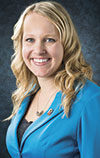Corn may be king, but cattle feeders ought to think about forage, too, he said.
“The total feed needed to get a steer to market is 85 percent forage because there’s a cow somewhere that’s being fed a forage-based diet,” Erickson said. He also noted intake during backgrounding and feeding, before comparing that nearly 14,000 pounds of forage to the average 3,300 pounds of concentrate fed during the finishing phase.
“That emphasizes that forages are critically important to the beef industry,” he said.
Although grain prices have come down, forage has seen a significant increase. One ag economics five-state survey shows that pasture rates in the upper Midwest have increased by $35 per animal-unit-month in just five years to a current $60 average.
Distillers grains are still competitive compared to corn, but not the significant discount they used to be.
“You got used to pricing things on a protein basis,” Erickson said. “You need to price things on an energy basis, because I think it affects your bottom line more than protein. I’m not trying to say this is gospel, but to get you to think about pricing.”
Feed prices are one part of the breakeven equation, but producers must consider what they’ll get for finished animals, too. Many are increasing saleable pounds right now, Erickson said, noting the strong trend toward higher carcass weights. Grades have followed a similar higher plane over the last five years.
Genetics have played a role, but “increasing days on feed and making cattle into yearlings are the two quickest ways to increase mature weight,” the animal scientist explained.
Any advantages for calf-feds must be weighed against their generally greater health challenges and lighter finished weights, he noted.
“Yearlings always eat more per day and gain more per day but are less efficient from a conversion standpoint, but they’re bigger when they get done,” Erickson said, sharing data to back up that claim.
In one study, his team applied a real-world filter, taking one set of calves and putting the heavier half (642 pounds) on feed right away, making the 526 pound calves into yearlings.
“Why am I comparing apples to oranges? Because you would not feed apples and oranges in the same way,” he said.
In that instance, the calf-feds had a feed-to-gain ratio of 5.63, with an average daily gain (ADG) of 3.81, and ended up at 1,282 pounds. The backgrounded calves had a 4.53-pound ADG and converted at 6.76 pounds of feed per pound of gain. They ended with a 1,365-pound final weight, giving the yearlings a 52-pound hot carcass weight (HCW) advantage.
“The risk on feeding yearlings is overweight carcasses. The risk on feeding calf-feds is yield grade fours,” Erickson said, noting the older animals had a nearly 7-point higher choice percentage in this case study.
Research comparing cattle purchased at the same time and then randomly allocated revealed similar performance trends but put the exclamation point on mature weight gain. The calf-feds finished with a 774-pound HCW, compared with 919 pounds for the fall yearlings.
“If you want to add more than 140 pounds of carcass weight, you can do that just by keeping them growing on grass or on forage,” he said. “That’s a big impact.”
But once they’re in the yard, how long should cattle remain on feed?
The longer the better, Erickson said. To what point? Researchers don’t know yet.
“Our job is to test the limits so you don’t have to,” he said. “Average daily gain goes down as you increase days on feed. That’s proven. But carcass rate of gain doesn’t appear to be dropping off dramatically as we feed cattle longer. With corn prices and cattle prices where they’re at today, there is an incentive to feed them longer,” he said.
There is also an opportunity to take greater advantage of corn stalks.
“The data are quite clear that, on average, as we produce more corn grain, we produce exactly the same amount more corn residue,” Erickson said. In turn, recent yield increases create more opportunity.
Studying silage plans, harvesting a bit later and drier could improve profitability, too.
“If you want to maximize yield and theoretically quality, harvesting silage in the black layer is the target,” he said.
Earlage, steam flaking, sweet bran and other topics came up as areas to explore.
“You decide profitability in many cases when you buy the cattle, but what you do on the cost-of-gain side is important,” Erickson said. ![]()
—From Certified Angus Beef news release
PHOTO: Galen Erickson talked about everything from feedstuffs to growing and finishing decisions at the Feeding Quality Forums last month in La Vista, Nebraska, and Garden City, Kansas. Photo provided by Certified Angus Beef.







